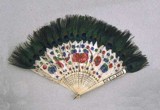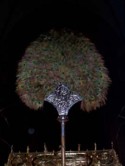
fig.6
Detail of
the "Adoration of the kings" by Fra Angelico and Filippo Lippi;
the peacock sits on top of the manger, approx. 1400-1465
www. onlinekunst.de
 fig.8
fig.8
Chinese
goose feather fan peacock feathers as decoration approx. 1850
www.museolugo.org/exposicion/
expo_aba.htm
PEACOCK'S PLEADINGS continued - page 2
Christianity
venerates the peacock for different reasons: From antique sources and
from St. Augustin we learn that peacock meat does not rot. That made
the peacock the symbol for eternity and eternal life. Paintings of the
paradise of the 15 and 16 c. (mainly Dutch) depict the peacock, sometimes
though looking like a turkey (both are poultry, and their affinity can
still be recognized in the Spanish word "pavo" for turkey
and "pavo real" for peacock).
Simultaneously, the peacock became the symbol for sin. "The horrible
scream of the peacock when he realized the ugliness of his feet, became
a metaphor for human beings who, despite of all beauty and excellence,
realize their sins". (http://www.cityinfonetz.de/tagblatt/archiv/kunstbeilagen/bibel/pdf/10.pdf)
Besides the Flabellum
to whisk away insects from the altar (first mentioned in the Constitutiones
apostolicae, 1 c. A.C.), two high peacock feather fans were used to
escort the Pope at festive occasions, sometimes also called "flabellum",
see fig. 8. According to Buss (Library No.54), these fans personify Cherubim
on which the Pope based his ecclesiastic power.

fig. 8
Detail of P. Bertelli's costumes' book, 1592 Padua, in "Kunst und Mode aus 5 Jahrhunderten"
Later on,
the peacock became symbol for arrogance and vanity, due to his superb
beauty. A fan called "Allegory of vanity" by Ludwig von Hofmann
painted in symbolism style, is mentioned and shown in C. Kammerl's first
class reference book "Der Fächer" (photo-No. 156, p.
237, Library No. 23). The same metaphor is used in Fritz Lang's film
classic Metropolis, where a peacock escorts seducing women whereas the
virginal Maria of the film is surrounded by white birds .(www.mytholyoke.edu/~ahstroud/uebertriebene.html).
Already 400 years earlier, Carpaccio used the symbolism of the peacock
as animal of luxury and sin to give a special note to his painting "Two
Venetian ladies": together with other symbols like a parrot, a
dwarf, a pet dog and 'chopines', the typical Venetian plateau shoes,
the two ladies can be identified as courtesans. (www.kfki.hu/~arthp/art/c/carpacci/5/01ladies.jpg)

fig.7
Procession
peacock fan of the Hl.
Liborius in Paderborn

fig.9
"Donzella di Millano"
"Varij vestitus in picturis praesertim Venetianorum et quorundam
Italorum", Beginning 17 c. (S.17 in "Kunst und Mode aus 5
Jahrhunderten")
fig.10
Fire
screen, water-colors/Gouache on paper, end 18 c./beginning 19 c. (?)
[click the photo for bigger image and more info]
The Renaissance period brought feather fans to a first zenith. However, only one depiction of the so-called "Donzella di Millano" (fig. 9) shows a peacock feather fan. Therefore, it can be assumed that the majority of feather fans consisted of ostrich feathers artfully dyed in Italy.
In the 18 century, the "golden era" of the fan, feather fans disappear totally. Mythological representations show Hera-Juno escorted by peacocks. The peacock feather becomes a symbol of a married woman. 19 century remakes of 18 c. fans show the same symbol (e.g. photo No. 123, p. 210, C. Kammerl, Library No.23).
From 1800 onwards, small silken fans embroidered with sequins in floral or geometrical designs were in fashion. Sometimes persons were depicted. The catalogue of the "Mainfränkisches Museum Würzburg" (Library No. 29) shows a fan with a peacock embroidered in golden sequins (p. 138).
Around 1850, (painted) goose feather fans with peacock feathers as decoration were produced in China. They were export fans for Europe (see fig.8.).
During the second half of the 19 century, the peacock re-appears as decoration on fans. In particular artistic lace fans depict the peacock, one example is shown as No. 85 in "Unfolding Beauty" (Library No.32) made of black Chantilly-lace. The interest for everything exotic or oriental is a side-effect of the world exhibitions. It inspired fashion as well as arts where Art Nouveau takes up the floral flow whereas the later Art Déco imitates and transforms the far-eastern clear geometrical ornaments. Feathers and fans experience a new - and last - high time before the final crepuscule.
fig.11
Detail of the sticks of fan of the second quarter of the 18 c.
[click the photo for bigger image and more info]

